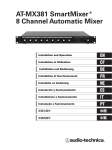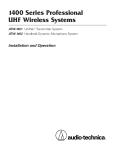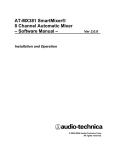Download Classe Audio CAP-101 Specifications
Transcript
AT-MX341b SmartMixer ® Automatic Microphone Mixer AUTOMATIC MICROPHONE MIXER Gain 1 Gain 2 Gain 3 AT-MX341b Master Threshold Output Level Gain 4 -20 -10 -6 -3 0 +3 +6 Priority Pre-select Manual Power Selected Channel Installation and Operation 1 2 3 4 Master Level Lockout Contents Introduction .....................................................................................................................3 ‚ What is a SmartMixer ? .........................................................................................................3 Features ..................................................................................................................................3 Front Panel .............................................................................................................................4 Rear Panel ..............................................................................................................................5 Installation and Setup ..............................................................................................6 Priority Microphones and Lockout Bus ................................................................................6 Preamplifier Gain ...................................................................................................................7 Output Gain ............................................................................................................................7 Phantom Power .....................................................................................................................7 Output Level LED Meter ........................................................................................................8 Adjusting “Off” Attenuation .................................................................................................8 Control Voltage Out ...............................................................................................................9 Daisy-chaining Mixers .........................................................................................................10 Rack Mounting .....................................................................................................................10 Security Caps .......................................................................................................................10 Specifications ...............................................................................................................11 Caution To prevent fire or shock hazard, do not expose this apparatus to rain or moisture. To avoid electric shock, do not open the cabinet. Refer servicing to qualified personnel only. To prevent fire, do not place any naked flame sources (such as lighted candles) on this apparatus. To prevent fire, do not cover the ventilation of this apparatus with newspapers, table-clothes, curtains, etc. Do not expose this apparatus to drips or splashes. Do not place any objects filled with liquids, such as vases, on this apparatus. Do not install this apparatus in a confined space such as a bookcase or similar unit. Install this apparatus only in places where ventilation is good. This apparatus should be located close enough to the AC outlet so that you can easily grasp the AC adapter at any time. In case of emergency, disconnect the AC adapter quickly. Compliance with FCC rules (USA only) This class B Digital device complies with part 15 of the FCC Rules. Operation is subject to the following two conditions: (1) This device may not cause harmful interference, and (2) this device must accept any interference received, including interference that may cause undesired operation. Caution for FCC You are cautioned that any changes or modifications not expressly approved in this manual could void your authority to operate this equipment. Note: This equipment has been tested and found to comply with the limits for a Class B digital device, pursuant to part 15 of the FCC Rules. These limits are designed to provide reasonable protection against harmful interference in a residential installation. This equipment generates, uses and can radiate radio frequency energy and, if not installed and used in accordance with the instructions, may cause harmful interference to radio communications. However, there is no guarantee that interference will not occur in a particular installation. If this equipment does cause harmful interference to radio or television reception, which can be determined by turning the equipment off and on, the user is encouraged to try to correct the interference by one or more of the following measures: --Reorient or relocate the receiving antenna. --Increase the separation between the equipment and receiver. --Connect the equipment into an outlet on a circuit different from that to which the receiver is connected. --Consult the dealer or an experienced radio/TV technician for help. IC statement (Canada only) This Class B digital apparatus complies with Canadian ICES-003. Cet appareil numerique de la classe B est conforme a la norme NMB-003 du Canada. 2 Introduction Please Note! This manual assumes use of microphone-level inputs and line-level output, the most typical SmartMixer application. However, all inputs and the output may be individually switched internally to achieve any combination of mic- and line-level input/output. See page 8 for details. About internal adjustment Operating personnel must not remove equipment covers. Only qualified, experienced, authorized service personnel may remove equipment covers for any internal adjustments. Important caution for service personnel making internal adjustments High voltages are present when the unit’s power cord is plugged into an electrical outlet. Service personnel should not make any internal adjustments with power cable connected. Disconnect the power cord from its source before removing equipment cover, because of the danger of touching an internal high voltage part. Also, to avoid injury, take care not to touch any sharp edges within the unit, its top panel or interior sections. What is a SmartMixer ® ? The AT-MX341b SmartMixer® Automatic Microphone Mixer is a microprocessor controlled, automatic switching, four-channel microphone mixer. The microphone inputs are XLRF-type balanced, with 12-volt phantom power available on pins 2 and 3. The output is XLRM-type balanced, non-inverting. AT-MX341-model mixers can be daisy-chained via the included AT8325/1.0 Link Cable and special connectors on the rear panel. The control bus and the audio are carried between mixers by the link cable. The result is that all microphones on a multi-mixer system can be controlled by one microphone connected to any mixer. Since all of the mixers are independently powered, there is no practical limit to the number of SmartMixers that can be daisy-chained. Features To custom-tailor conferencing needs, the mode of each microphone channel can be independently switched via the front panel “priority pre-select” DIP switches. The combination of switch settings results in three different modes of priority selection/operation. In any of the three modes of automatic operation, when everyone stops talking, the last microphone “on” will remain “on.” In a teleconferencing, recording, or broadcast application, this feature will provide continuous room ambience. This feature is cascaded throughout all linked mixers so that only one microphone in the entire system will remain on. Each input channel has an independent gain control on the front panel. Substantial gain reserve and adjustment range permits microphones of widely differing sensitivities to be used together successfully. When a microphone is “off,” its input is only attenuated. This attenuation is factory set at 8 dB. The amount of “off” attenuation can be internally adjusted between 6 dB and 20 dB if desired. (See page 8, “Adjusting ‘Off ’ Attenuation.”) A “manual” setting on the front panel bypasses the AT-MX341b’s automatic switching and attenuation functions, causing the unit to behave like a conventional 4-channel mixer. In this mode, the relative level of each microphone is strictly a function of the position of its respective front-panel gain control. 3 AT-MX341b Front Panel 1. Power switch. 2. Power “on” indicator. 3. Input Gain controls. Adjust inputs for microphone sensitivities and/or operating conditions. 4. Selected Channel LED indicators. Indicate which channels are “on” or “active.” 5. Output Level LED meter. Indicates RMS output level of the mixer. “Zero” (0) level is factory calibrated for an output of +4 dBm into 600 ohms (Master Level control fully clockwise). Can be set for peak output level indication via internal switch (see page 8). 6. Priority Pre-select switches. A switch in the “up” position assigns the respective channel priority over the other channels. A priority channel can not be locked out by other channels. Any combination of priority/non-priority selections is allowed. 7. Master Level control. Normal setting is fully clockwise (full output). If reducing the mixer’s output is necessary, carefully turn the control counter-clockwise as needed with a small screwdriver. Once set as desired, the control may be protected from unauthorized adjustment by covering the panel hole with a sticker provided with the security caps. (This control does not affect the meter indication.) 8. Master Threshold / Manual control. Sets the reference level that must be exceeded for a microphone to be considered “in use.” Adjust to keep background noise level from triggering microphones. “Manual” setting bypasses all of the SmartMixer’s automatic functions. 9. Lockout LED indicator. Shows when lockout bus is active. Also aids in setting Master Threshold. ➋ ➎ ➑ Output Level Master Threshold ➌ AUTOMATIC MICROPHONE MIXER Gain 1 Gain 2 Gain 3 AT-MX341b Gain 4 -20 -10 -6 -3 0 +3 +6 Priority Pre-select Manual Power Selected Channel ➊ ➍ Figure 1. Front panel 4 4 Control Voltage Out 3 2 1 GND 1 2 3 4 Master Level Lockout ➏ ➐ ➒ AT-MX341a Rear Panel AUTOMATIC MICROPHONE MIXER AT-MX341b Master Output Level 1. Power input. Gain Requires 12 volts AC or 15-18Gain volts DC, either polarity; 300 mA. Threshold 1 Gain 2 Gain 3 4 0 -3 +3 +6 -20 -10 -6 2. Link In /Out. Provides for daisy-chaining of multiple mixers when more than four microphones are used. Priority Pre-select Manual 3. Control Voltage Out. Provides 0 to +4 VDC (active high) to trigger external devices such Master 1 2 3 4 Level as Power speaker switching,Selected camera switching and indicator lights. Lockout Channel 4. Output. Balanced line-level output. Can be changed to mic-level output via internal switch (see page 7). XLRM-type connector. 5. Inputs. Balanced microphone inputs for low impedance dynamic or condenser mics. Can be changed to line-level inputs via internal switches (see page 7). XLRF-type connectors. ➌ 4 3 2 ➎ ➍ 1 GND Control Voltage Out 12V AC/15-18V DC Link In Link Out ➊ ➋ Output Input 4 Input 3 Input 2 Input 1 Figure 2. Rear panel 5 Installation and Setup AT-MX341b SmartMixer setup tips: 1. Turn Master Threshold control to minimum threshold, immediately clockwise of the “Manual” setting. 2. Set all Priority DIP switches to “down” position. 3. Turn all four microphone Gain controls fully counter-clockwise. 4. Connect the AC adapter to the mixer and plug in to outlet. 5. Turn Power switch “on.” The mixer will perform a self-test and turn each microphone “on” and “off ” consecutively. 6. Connect a microphone to Input 1 and turn the Gain 1 control to the “nine o’clock” position. The channel 1 LED will light if the microphone is operational. 7. Adjust the Gain 1 control for proper meter indication when speaking into microphone (peaks at 0). 8. Gradually increase the Master Threshold control until the Lockout LED flashes when speaking at a normal level. 9. Plug in up to three other microphones and adjust each respective Gain control for proper meter indication. It should not be necessary to readjust the threshold level. 10. Priority can be assigned to one or more microphones by moving the appropriate DIP switch(es) to the “up” position. Any microphone(s) assigned in this manner cannot be locked out by any other microphone. 11. “Manual” mode can be selected at any time by simply turning the Master Threshold control fully counterclockwise. In this mode, the unit will behave like a conventional four-channel microphone mixer (all automatic functions are bypassed). 12. The Master Level recessed control on the front panel may be adjusted with a small screwdriver if necessary. This control is at the last stage in the mixer, and does not affect microphone gain, threshold setting, or meter indication. Priority Microphones and the Lockout Bus Once the Master Threshold control has been properly adjusted, an audio signal appearing in any channel causes the lockout control bus to activate and the Lockout LED indicator to light. The Priority Pre-select switches then determine whether or not a particular mic is affected by lockouts caused by other mics: a channel Priority switch in the “down” position will allow lockout* of its mic; the same switch “up” will not allow lockout of its mic. * Note that any mic which is described as “locked out” or “off ” is really just being attenuated by between 6 dB and 20 dB from the level otherwise determined by its Gain control setting, sensitivity and placement. See the “Daisy-chaining Mixers” section on page 10 for further details. There are basically three “modes” of automatic operation: Mode 1... All Priority Pre-select switches Up The Lockout indicator will come on with any audio input, but no mic will be locked out…because none are connected to the lockout bus. (This mode is often called “Free-for-all”…or sometimes “City Council”!) 6 Mode 2…All Priority Pre-select switches Down In this mode, only one mic at a time can be “on.” The lockout bus shuts down all other mics until the first speaker pauses. As soon as the controlling microphone goes silent, the lockout bus goes inactive and any other mic can come on. This switching takes place without any syllable-grabbing delay, or pops or clicks. (This mode is known as “First-come-first-served” or “Filibuster.”) This mode is very useful when the gain setting of the overall sound system must be close to the threshold of feedback, and additional microphones coming on could throw the system into feedback. The SmartMixer will not allow multiple microphones to be on at the same time in this mode. The switching is so fast and silent that the meeting can still be completely interactive. Mode 3…One Priority Pre-select switch Up The selected priority microphone can come on at any time and can mute any other mic that is on (popularly called “The Chairperson” mode). (Note that there may be special circumstances where two or three mics could be set to priority, so those speakers could talk whenever desired, but still mute one or two non-priority mics.) If multiple SmartMixers are used with AT8325/1.0 Link Cables, Priority Pre-select switches on all channels in use will have the control effects described above. The selected priority microphone(s) will mute only those non-priority microphones within the same unit. Preamplifier Gain The SmartMixer has a substantial gain range, allowing it to accept a wide variety of microphones. However, if in some instances higher-output microphones are used for close talking, it may be necessary to reduce the preamplifier gain. This can be done by changing switch settings inside the unit. With the unit unplugged, remove the two screws on each side of the unit and remove the top cover. Locate the internal switches designated on the circuit board by “S103,” “S203,” “S303” and “S403” (Figs. 3 and 4, page 8). Changing the settings of these internal switches will cause a gain reduction of 10 dB for channels 1, 2, 3 and 4 respectively. The preamplifier gain may be reduced further, allowing the SmartMixer to accept line-level sources. Changing the settings of the internal switches designated by “S101,” “S102,” “S103” and “S104” will cause an input reduction of 50 dB for channels 1, 2, 3 and 4 respectively. Note that the appropriate internal switches can be used in combination for a total sensitivity reduction of up to 60 dB for each channel. Output Gain The SmartMixer’s output is factory set at line level. Should mic-level output be desired, simply unplug the unit, remove the top cover and locate the switch on the circuit board marked “S501” (Figs. 3 and 4, page 8). Changing the setting of this switch will cause a 50 dB reduction in output. Phantom Power Each of the SmartMixer’s inputs supplies +12V DC phantom power. Should it be required to disable the phantom power, simply unplug the unit, remove the top cover and locate the switches designated on the circuit board by “S102,” “S202,” “S302” and “S402” (Figs. 3 and 4, page 8). Changing the settings of these switches will disable phantom power on channels 1, 2, 3 and 4, respectively. Note that, although they do not require phantom power for operation, most balanced-output dynamic microphones can be used without disabling the SmartMixer’s phantom power. 7 Rear Panel Output Level LED Meter The Output Level LED meter is factory set to indicate RMS output. Should peak output indication be desired, simply unplug the unit, remove the top cover and change the setting of the switch designated on the circuit board by “S602” (Figs. 3 and 4). “Zero” (0) level is factory-calibrated at +4 dBm into 600 ohms. Don't Touch ! Figure 3. Internal view of mixer. OFF 0dB LINE S602 S403 -10dB MIC S501 ON OUTPUT ATT MIC S402 0dB PAD -10dB LINE S401 OFF S303 PAD 0dB ON INPUT ATT PHANTOM -10dB MIC S302 OFF S203 PAD 0dB S103 PAD -10dB ON LINE S301 OFF MIC S202 S102 ON INPUT ATT PHANTOM MIC LINE S201 INPUT ATT PHANTOM S101 INPUT ATT PHANTOM LINE PEAK RMS METER RESPONSE VR102 GATE ATT -20dB -6dB VR202 VR302 GATE ATT -20dB -6dB GATE ATT -20dB -6dB VR402 GATE ATT -20dB -6dB Figure 4. Detail of internal controls. Adjusting ”Off” Attenuation In instances when the number of microphones in use is high, it may be necessary to increase the amount of “off ” attenuation per microphone to keep the total ambient noise level low. There are “off ” attenuation adjustments inside the unit. To adjust the “off ” attenuation of channel 1, unplug the unit, remove the top cover and locate the trimpot designated on the circuit board by “VR102” (Figs. 3 and 4). It is factory set at approximately 8 dB, the attenuation at the middle of the control’s rotation. When the control is turned fully counter-clockwise, “off ” attenuation is approximately 20 dB. Conversely, when the adjustment is turned fully clockwise, “off ” attenuation is approximately 6 dB. VR202, VR302 and VR402 control “off ” attenuation for channels 2, 3 and 4 respectively. 8 Control Voltage Out When a microphone channel turns “on,” as indicated by a Selected Channel LED on the front panel, the channel’s associated Control Voltage Out goes “high” (+4 VDC). This signal can be used to light indicator lamps, switch speaker zones on and off, select video cameras, etc. The control voltage should not be connected directly to an inductive load such as a relay coil, as damage to the mixer may result. Several interface circuit possibilities are shown in Figure 5. Figure 5. Control interface examples. 9 Daisy-chaining Mixers When more than four microphones are needed, it is possible to daisy-chain multiple SmartMixers together through the Link In/Out connectors on the backs of the units (Fig. 2). Connect Mixer #1 Link Out jack to Mixer #2 Link In jack, etc. Mixer #1 output contains only audio from the first four microphones; Mixer #2 output then contains audio from all the microphones plugged into Mixer #1 and the microphones plugged into Mixer #2. The last mixer in the chain contains audio from all preceding mixers. The combined output is then taken from the last mixer in the chain. Because lockout information is passed between mixers through Link In / Out, the last-microphone-on condition is not violated. Thus only one microphone per installation will stay on when no one is speaking. Note that one or more mixers can be switched to “Manual” mode without affecting the automatic operation of any other mixers in the chain. Rack Mounting Provided with each mixer are two rack ears, one long and one short, and six self-tapping screws to attach the ears to the unit. When using more than one SmartMixer in a system, it may be advantageous to mount two mixers in a 1U rack space. This can be accomplished using the two short rack ears and an optional joining plate (Model AT8628), which allows two units to be connected side-by-side in a single rack space. Security Caps For permanent installations where microphone selections, positions and acoustic conditions are constant, it may be advantageous to remove the front panel knobs and install security caps to prevent unauthorized adjustments. To install, simply press the caps into place, covering the Gain and Threshold controls. Place the provided sticker over the Master Level access opening in the panel. The system should be tested carefully before installing the security caps because they are intended to be “permanent” and are very difficult to remove. If removal of installed security caps becomes necessary, first remove the two screws on each side of the unit and remove the top cover. Then remove the six screws that attach the front panel: four on top and two underneath. Remove the front panel. With the panel removed, the two locking tabs on each security cap can be accessed. The cap can be released by carefully squeezing the two tabs together. 10 Specifications † Input Impedance Mic . . . . . . . . . . . . . . . . . . . . . . . . . . . 4,000 ohms Line . . . . . . . . . . . . . . . . . . . . . . . . . . . 30,000 ohms Output Impedance Line . . . . . . . . . . . . . . . . . . . . . . . . . . . 200 ohms Mic . . . . . . . . . . . . . . . . . . . . . . . . . . . 320 ohms Maximum Input Level Mic . . . . . . . . . . . . . . . . . . . . . . . . . . . –20 dBV Line . . . . . . . . . . . . . . . . . . . . . . . . . . . +30 dBV Maximum Output Level* Line . . . . . . . . . . . . . . . . . . . . . . . . . . . Mic . . . . . . . . . . . . . . . . . . . . . . . . . . . Nominal Output Level (0 VU)* Line . . . . . . . . . . . . . . . . . . . . . . . . . . . Mic . . . . . . . . . . . . . . . . . . . . . . . . . . . +14 dBm (600 ohms) –40 dBm (600 ohms) +4 dBm (600 ohms), +4.4 dBV (open circuit) –46 dBm (600 ohms), –44 dBV (open circuit) Maximum Gain . . . . . . . . . . . . . . . . . . . . ≧70 dB Frequency Response . . . . . . . . . . . . . . . 60 Hz to 30 kHz at –3 dB points Dynamic Range1 . . . . . . . . . . . . . . . . . . . 75 dB ±10 dB, dependent upon gain control settings Equivalent Input Noise . . . . . . . . . . . . . –120 dBV (150 ohms) at maximum gain Input Attenuation . . . . . . . . . . . . . . . . . . 10 dB Mic/Line Input Pads . . . . . . . . . . . . . . . . 50 dB Microphone Phantom Power . . . . . . . . +12V DC Control Voltage Out . . . . . . . . . . . . . . . . +4V DC Power Supply . . . . . . . . . . . . . . . . . . . . . . 12V AC or 15-18V DC, either polarity; 300 mA Operating Temperature . . . . . . . . . . . . . 32° to 104° (0° to 40° C) Dimensions . . . . . . . . . . . . . . . . . . . . . . . . 8.25" (210 mm) W x 9.38" (238 mm) D x 1.75" (44 mm) H (including feet, knobs and connectors) Weight . . . . . . . . . . . . . . . . . . . . . . . . . . . . 3.1 lbs. (1.4 kg) Included Accessories . . . . . . . . . . . . . . . AC adapter, AT8325/1.0 Link Cable Optional Accessory . . . . . . . . . . . . . . . . AT8628 Double Rackmount Joining Plate † In the interest of standards development, A.T.U.S. offers full details on its test methods to other industry professionals on request. * Master Level control at maximum (fully clockwise). 1 Input terminated with 150 ohms, A-weighted using Audio Precision System One. Summary of Internal Controls Function Ch 1 Ch 2 Ch 3 Ch 4 Output 50 dB Mic /Line Atten. S101 S102 S103 S104 S501 12V Phantom Power S102 S202 S302 S402 -- 10 dB Input Atten. S301 S302 S303 S403 -- “Off” Attenuation VR102 VR202 VR302 VR402 -- -- -- S602 Meter RMS/Peak --See diagram on page 8 for locations/positions. 11 P52324 ©2011





















